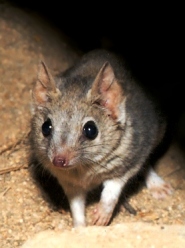 The Kowari (Dasycercus byrnei) is a small carnivore marsupial that lives in the central areas of Australia that have dry grasslands and also the deserts. It is similar in appearance to a mouse or a gerbil, however it is known as a very efficient predator of spiders, insects, small lizards, and other small animals. It grows to 18 centimeters (7 inches) in length and has a 14 centimeter (5.5 inch) long tail. They are light on their feet, very quick, and are usually a molted brownish ash color, with a lighter underbelly, and the same light to white fur on their legs. They have large ears, eyes, and an excellent nose, and can track prey and strike with lightning speed.
The Kowari (Dasycercus byrnei) is a small carnivore marsupial that lives in the central areas of Australia that have dry grasslands and also the deserts. It is similar in appearance to a mouse or a gerbil, however it is known as a very efficient predator of spiders, insects, small lizards, and other small animals. It grows to 18 centimeters (7 inches) in length and has a 14 centimeter (5.5 inch) long tail. They are light on their feet, very quick, and are usually a molted brownish ash color, with a lighter underbelly, and the same light to white fur on their legs. They have large ears, eyes, and an excellent nose, and can track prey and strike with lightning speed. The Kowari is a part of the genus Dasyuroides, which it is the only member of. They are a part of the tribe Dasyurini which contains many other species and genus, such as the Qualls, the Kaltula, Masupial Shrews, and Tasmanian Devil. The tribe belongs to the subfamily Dasyurinae which has one other tribe besides Dasyurini. This belongs to the family Dasyuridae which is furthermore in the Infraclass Marsupialia. They share this infraclass with six other living orders, and two known extinct orders.
They have a set breeding period in the winter months of Austrailia, being between may and October, with a usual gestation (preganancy) time of around a month, and the litter will have between four and six newborns. Because of the short length of time it takes for gestation and maturity, it is possible for females to have two litters in a single winter. Weaning takes place after three months, and the young are adults within eight months after birth, however they live independently right after weaning from the mother’s pouch. The lifespan is between three to six years, while the maximum age for fertility seems to be around four years of age.
Interesting facts about Kowari:
- The Kowari has no need to find a source of water as long as there is food - it gets all of its moisture from prey.
- The Kowari may hunt small birds in addition to lizards and insects.
- The Kowari is a species at risk of extinction due to habitat loss and possibly disease, and is listed as Vulnerable in the IUCN
Picture of the kowari by Kořínek Milan, licensed under GFDL
The Kowari is listed as Vulnerable (VU), considered to be facing a high risk of extinction in the wild, on the IUCN Red List of Threatened Species
Countries
Australia
Custom Search